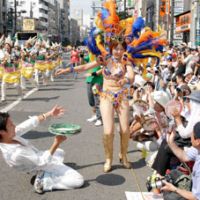Tokyo's Asakusa district, central to the capital's traditional shitamachi (downtown) area, will be filled with Brazilian rhythm on Aug. 30 for the 28th Asakusa Samba Carnival.
The event, held annually since 1981 on the last Saturday of August, was launched to revitalize the town by an association of local stores, modeling carnivals in Brazil. The festival drew some 500,000 spectators last year, according to the organizer.
The carnival, which runs from 1:30 to 6 p.m., is in contest style, and consists of two leagues. In the lower, or S2 league, nine teams will compete, while 11 teams will vie for honors in the higher S1 league. In total, some 4,700 participants will march while dancing, singing and playing musical instruments.
The samba teams select their own themes and make their own costumes.
The music they dance to is played by a percussion band called a bateria (Portuguese for "drums"). A bateria can consist of several different kinds of drums and rattles. Central to the samba rhythm are the powerful beats of the surdo (large, two-headed, cylindrical bass drums with a steel or wood shell), accented by shakers such as chocalhos and small snare drums. The dynamic and multilayered beats created by these instruments tend to sweep spectators into the samba spirit as well.
In addition to groups of dancers, who wear costumes representing particular themes, there are also solo dancers called passista, who often wear vivid-colored bikinis and feathers on their backs as they perform their dances.
At the 2007 festival, the team Uniao dos Amadores (Union of Amateurs) — which has taken part in the carnival since it began — won the S1 league for the first time in three years. Its members are mainly university students in the Kanto region. As last year's winners, Uniao dos Amadores will give the final performance of the carnival.
The parade starts from Umamichi Dori Street, which runs beside the Matsuya department store and Asakusa Station on the Tobu Line, and goes on to cross Kaminarimon Dori Street, which runs in front of the Kaminarimon Gate of Sensoji Temple. (The landmark gate is adorned with the large red lantern seen in many picture postcards of Tokyo.)
S2 league teams will start at 1:30 p.m., followed by the S1 league.
This carnival annually attracts large crowds of spectators and photographers, so competition can be stiff for a good spot along the 800-meter parade route.
The closest transportation hub is Asakusa Station, which serves the Ginza, Asakusa and Tobu lines. Kaminarimon Dori Street is also accessible from Tawaramachi Station on the Ginza subway line.
For more information, visit the carnival's official Web site (in Japanese only) at www.asakusa-samba.jp/index.htm


















With your current subscription plan you can comment on stories. However, before writing your first comment, please create a display name in the Profile section of your subscriber account page.